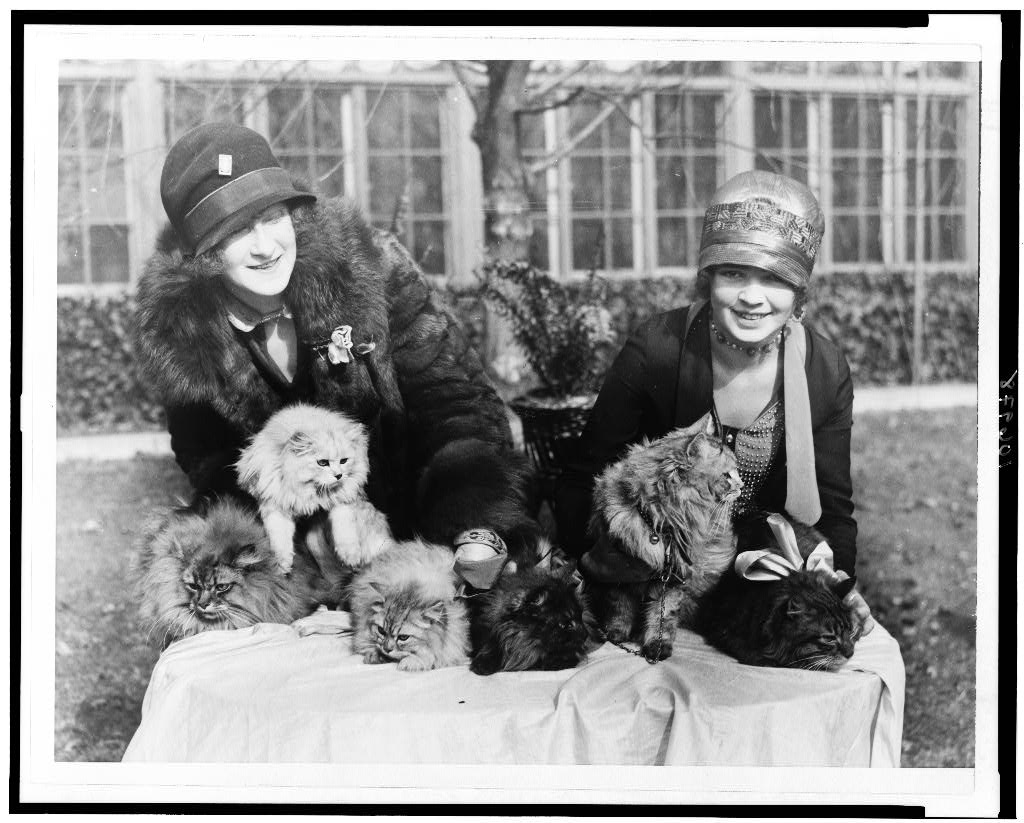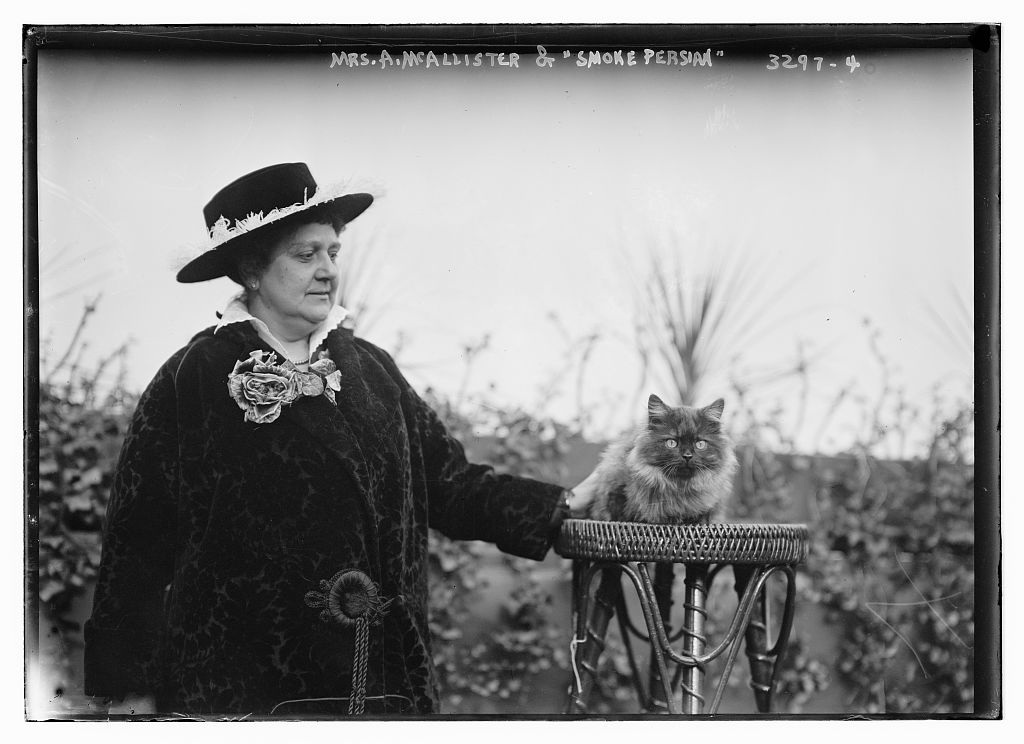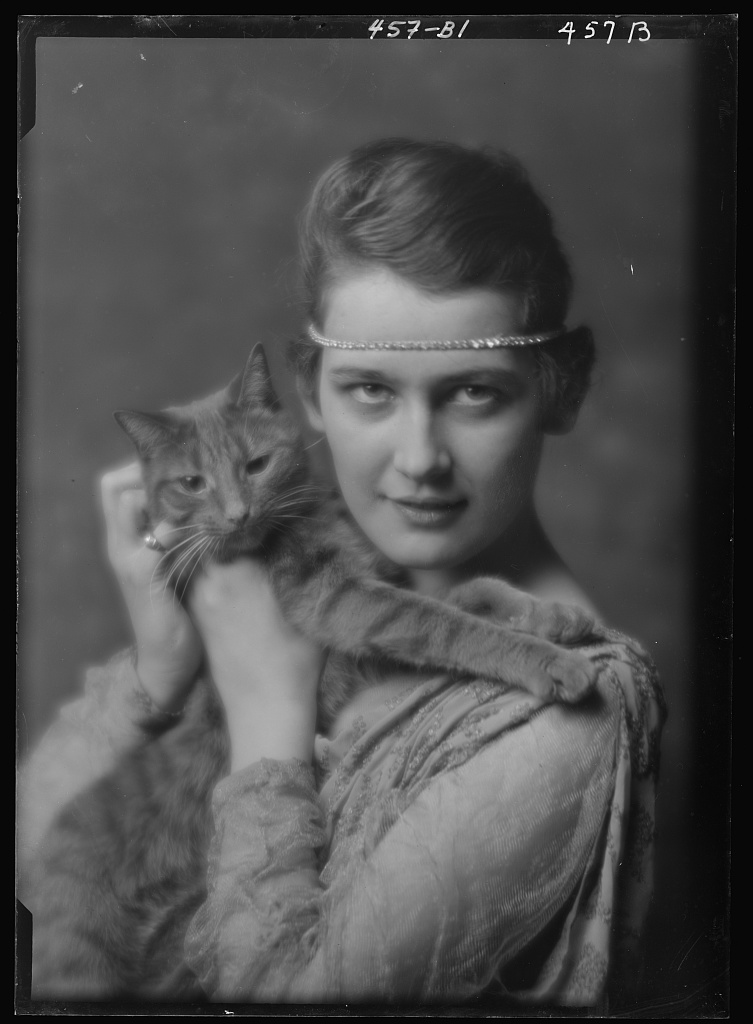Cats & Women: Why the Connection?
This blog post incorporates research conducted for an upcoming digital exhibition called “Wild Mouser to Household Pet: A History of Cats in Science and Society, 1858 to 1922.” Click here to check out the exhibition and book collection!
Cats and women have long been connected in the public imagination. From ancient Egypt, to the Middle Ages, to the turn of the twentieth century, to the present – there has been an association between felines and femininity.
| Gos., De Voogt. Our Domestic Animals: Their Habits, Intelligence, and Usefulness (1907). Painting by Henriette Ronner-Knip. Digitized by the Library of Congress. |
Pronouns
One of the most glaring examples of this connection is the choice of pronouns used to describe cats. These examples from nineteenth and early twentieth century books illustrate the tendency to use feminine pronouns for cats:
“If a cat is seen to wash her face with vigor, it is going to be stormy, and if she sits with her back to the fire, it predicts cold weather.” [1]
“The cat has been called the ‘perfect pet,’ and not without justice. Pussy has always had her friends and her foes; her ardent admirers and her extreme detestors. Faults she has, no doubt, but the lack of an affectionate regard for the person who befriends her is not, as has been alleged, one of them. Though less demonstrative than the dog, the quiet rubbing of her fur against one’s person is no less indicative of supreme regard.” [2]
Conversely, dogs were usually referred to with masculine pronouns.
“Crazy Cat Lady” Trope
Another example of the link between cats and women is in the ‘crazy cat lady’ trope. In Our Domestic Animals, Their Habits, Intelligence, and Usefulness (1907), the phenomenon is described:
“Yet in certain cities of every country we find persons who push their passion for cats to excess; generally, it must be said, they are elderly dames [women], who establish asylums where neglected, lost, or sick cats may find a refuge. Sometimes these asylums are organized in a practical and sufficient manner, in which case the motive that provided them is laudable; but often they are mere nests of disease and objects of scandal to the neighborhood.” [3]
This ‘crazy cat lady’ troupe is linked to earlier beliefs in the connection between femininity, witchcraft, and cats. The tradition has also continued on into the twenty-first century: it is common for people to joke about single women who live with cats as crazy or scandalous.
| James, Robert Kent. The Angora Cat; How to Breed, Train and Keep It. (1898). Digitized by the Library of Congress. |
Cat Shows
| Evening public ledger. (Philadelphia [Pa.]), 12 Dec. 1921. Chronicling America: Historic American Newspapers. Lib. of Congress. |
On the other side of the spectrum, women have also been associated with cat shows. The first United States National Cat Show took place in 1871. Women’s societies organized cat shows to raise money for charities, often animal welfare organizations. Newspaper articles from the time announce the upcoming shows and list the names of the exhibitors and organizers, who were mainly women. These shows also incorporated new scientific theories about heredity and breeding, as cat enthusiasts sought to selectively breed cats to develop particular traits, especially coat length and color.
 |
| Edna B. Doughty and Louise Grogan with Persian cats. 1920s. Library of Congress Prints and Photographs Division. https://lccn.loc.gov/93502603. |
 |
| Mrs. A.McAllister and “Smoke Persian” cat. Ca. 1910-1915. Library of Congress Prints and Photographs Division. http://www.loc.gov/pictures/item/ggb2005018109/. |
Another interesting visual representation of the connection between women and cats comes in the photography of Arnold Genthe (1869-1942). In the early twentieth-century, Genthe photographed many celebrities in his studio, posing them with his cat Buzzer. Click here to check out more photographs of Buzzer.
 |
| Miss Anna Holch with Buzzer the cat, portrait photograph. Ca 1913. Library of Congress Prints and Photographs Division. http://www.loc.gov/pictures/item/agc1996003492/PP/. |
But why was there a connection between women and cats?
In his book, The Cat: An Introduction to the Study of Backboned Animals, Especially Mammals (1881), St. George Jackson Mivart shares one theory:
“The cat also is favoured by that half of the human race which is the more concerned with domestic cares; for it is a home-loving animal and one exceptionally clean and orderly in its habits, and thus naturally commends itself to the good will of the thrifty housewife.” [4]
He highlights aspects of cat’s behavior that are seen as feminine in his day: domestic tendencies and cleanliness.
Another possible interpretation involves the intelligence and disposition of cats. In her text, Everybody’s Cat Book (1909), Dorothy Bevill Champion hints at a relationship between women and cats. She writes:
“Cats are very sensitive in disposition, and can easily be frightened by harsh treatment…” [5]
This description would have been in line with stereotypical descriptions of women. On that same page she writes:
“After the many cases I have seen of cat intelligence, I can only say, if a cat is stupid it is want of education.” [6]
Reading these two quotes together, we see that Champion is making a claim about both cats and women. A central debate of the women’s movement during this time was whether women were as intelligent as men. Many argued that women’s shortcomings were due to less access to education, and not because they were less intelligent. Champion’s claim can therefore be read as a defense of both women and cats.
| James, Robert Kent. The Angora Cat; How to Breed, Train and Keep It. (1898). Digitized by the Library of Congress. |
Also, cats and women tended to be linked and compared with dogs and men.
“I class the Cat and the Dog to be as distinct in their individuality and with as much difference as you see existing between man and woman.” [7]
For more information about comparisons between cats and dogs, see this blog post.
In the end, these examples show that by the start of the twentieth century, the connection between women and cats was prevalent.
Here are some books about cats written by women in the nineteenth and early twentieth centuries. They are digitized on the Biodiversity Heritage Library.
- Lucy Ellen Guernsey. Meat-Eater: With Some Account of Their Haunts and Habits. 1858.
- Harriet Mann Miller. Funny Friends; or, Queens Pets at Marcy’s. 1892.
- Helen M. Winslow. Concerning Cats; My Own and Some Others. 1907.
- Dorothy Bevill Champion. Everybody’s Cat Book; Containing Chapters on “colour breeding”, “showing”, “conditioning”, “judging”, “diseases and their treatment”, “how to raise and treat the show and pet cat”, and Many Valuable Prescriptions. 1909.
- Jeanie Oliver Davidson Smith. The Story of Zephyr; A Christmas Story. 1917.
- Ellen Celty and Anna Ray. Feeding and Care of the Domestic and Long-haired Cat. 1922.
*For more information about domestic cats in the nineteenth and early twentieth centuries, see the digital exhibition “Wild Mouser to Household Pet: A History of Cats in Science and Society, 1858 to 1922.”
[1] Jacob Biggle. Biggle Pet Book: A Collection of Information for Old and Young Whose Natural Instincts Teach Them to be Kind to All Living Creatures. 1900. Page 56.
[2] Thomas Earl. Pets of the Household; Their Care in Health and Disease. 1895. Page 155.
[3] Gos. De. Voogt. Our Domestic Animals, Their Habits, Intelligence and Usefulness. 1907. Page 83.
[4] St. George Jackson Mivart. The cat: an introduction to the study of backboned animals, especially mammals. 1881. Page 1.
[5] Dorothy Bevill Champion. Everybody’s Cat Book. 1909. Page 15.
[6] Dorothy Bevill Champion. Everybody’s Cat Book. 1909. Page 15.
[7] Marvin Clark. Pussy and her language. 1895. Page 51.





As a 70 year old man and lifelong historical-researcher, I have to agree about Women and Cats, but beg to point,out that “Men with a Cat” have existed far, far, back into history. read that medieval classic called “The Golden Legend”, which tells of a man who wanted to imitate Saint Gregory, but was told, “You love your pet cat too much to be able to love that saint”. Also, there is a contemporary biography of that saint Gregory, which says in his old age he gave up everything to live simply, but kept his dear pet cat close, till he died.